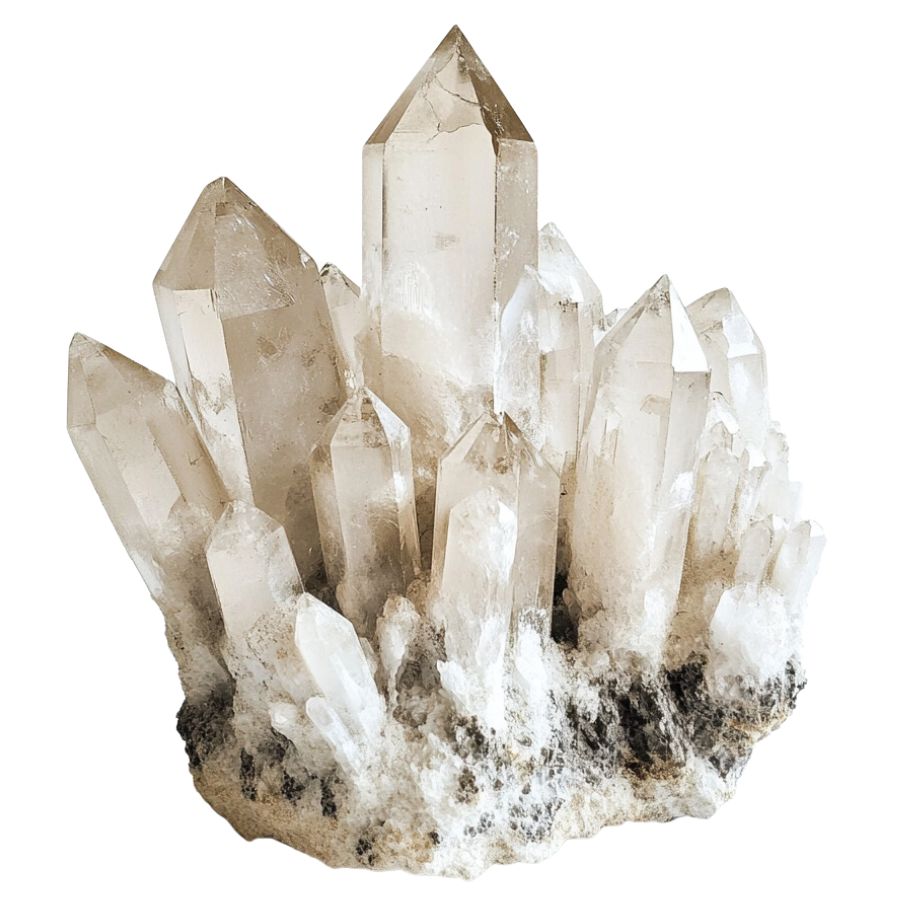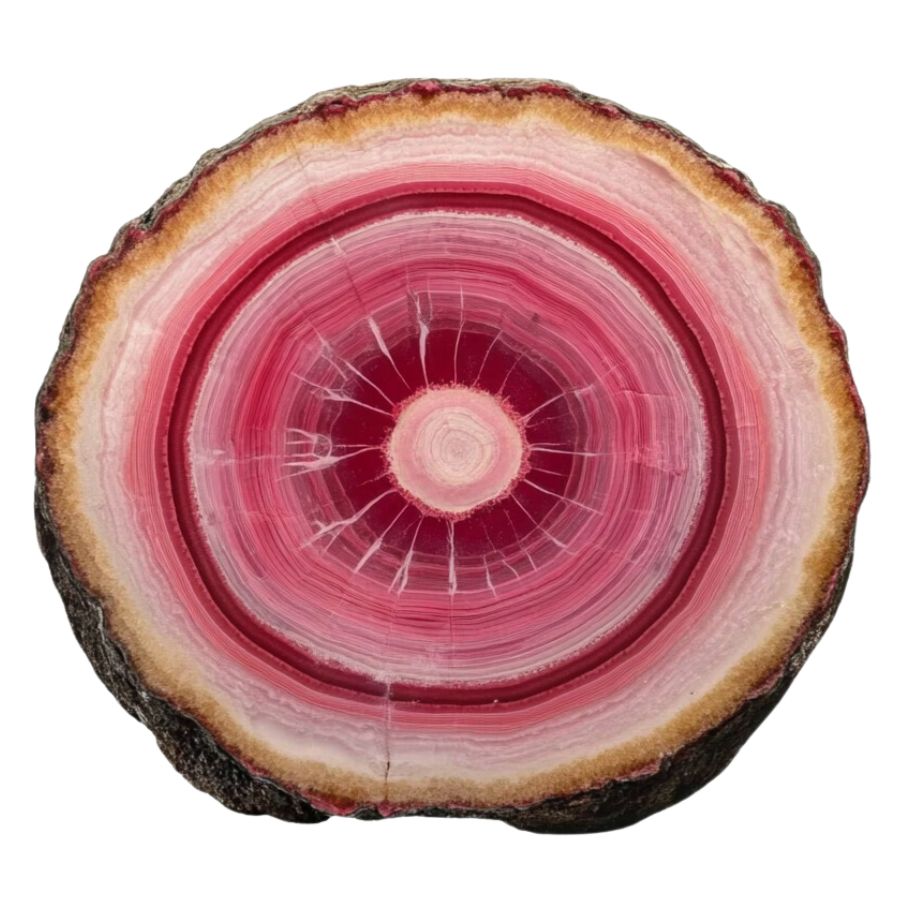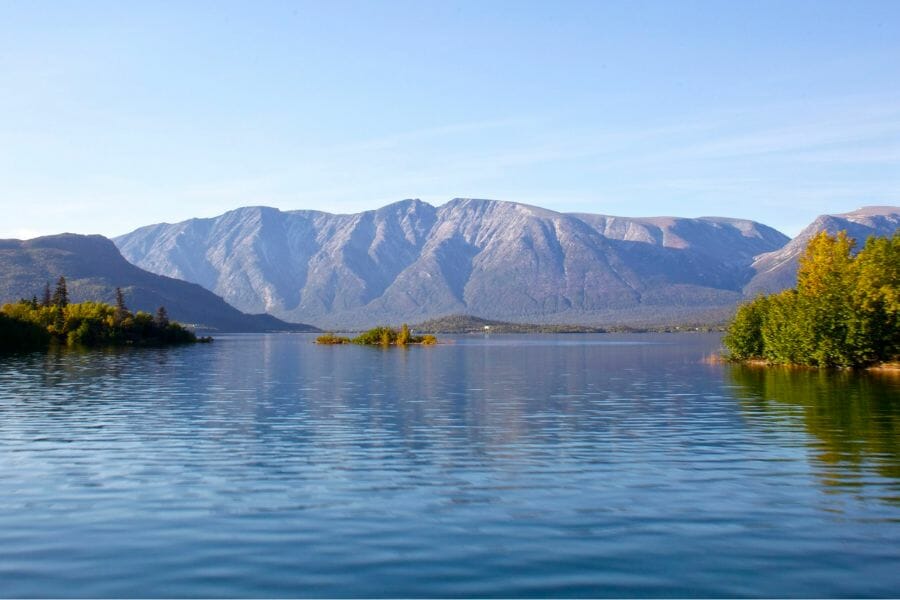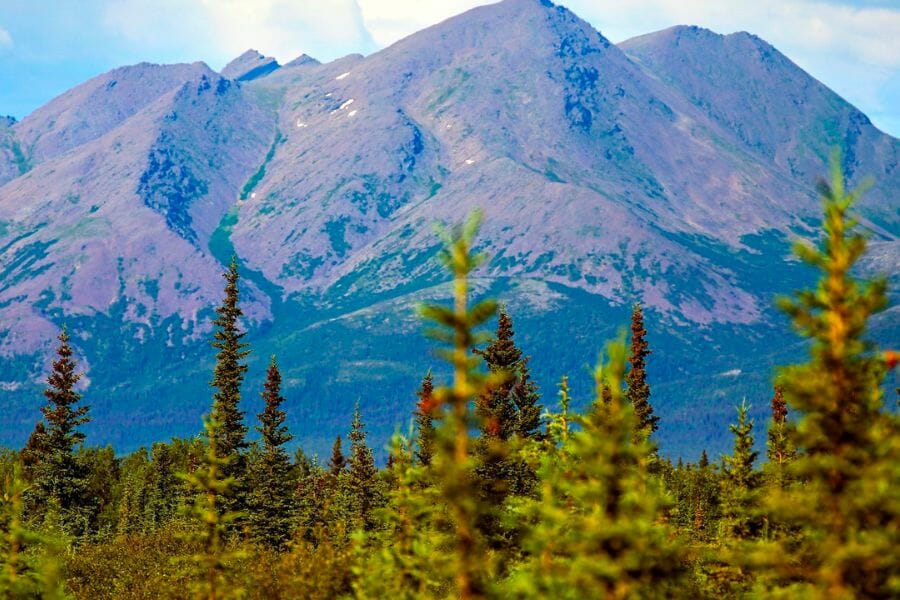Finding crystals can be a rewarding adventure, offering a unique way to explore the natural beauty and geology of the region. Whether you’re a seasoned rockhound or just getting started, knowing where to look is key to uncovering these hidden treasures.
In this state, a variety of locations provide opportunities to discover different types of crystals. From rocky outcrops in the mountains to stream beds that carry sparkling surprises, each area offers its own unique finds for those willing to search.
We can help you get started with some places you can explore for crystals below!
Crystals you can find in the US
The United States offers a wide range of crystals that reflect its diverse geology. From vibrant gems to more subtle mineral formations, there’s something to discover in nearly every region.
Calcite

With a variety of forms and a unique property of double refraction, calcite allows objects viewed through the crystal to appear doubled. This mineral can appear in a spectrum of colors, with pure forms typically being transparent or white.
In addition, calcite reacts vigorously with acids, which aids in distinguishing it from other minerals. It also frequently contributes to the structure of sedimentary rocks such as limestone.
Gypsum

Gypsum’s notable softness allows it to be easily scratched with just a fingernail, often presenting as white or very light-colored in its pure form.
It manifests in both crystalline forms, like selenite, and massive forms such as alabaster, making it versatile in use and appearance.
Gypsum is also essential in the construction industry and is a key component in the manufacture of plaster and drywall.
Fluorite

Fluorite comes in a wide range of vibrant colors, including purples, greens, blues, and yellows, and is known for forming in well-defined cubic crystals.
Beyond this, fluorite exhibits fluorescence under ultraviolet light! It can also be used in various industrial applications, including as a flux in steelmaking.
Galena

Galena distinguishes itself with a metallic luster and high density, typically found in a cube-like form. It serves as the primary ore of lead, making it important in the metal industry, while its shiny, silver color attracts collectors.
Not only does its appearance make it a subject of interest, but its weight and texture provide tangible lessons in mineral density and metallic properties. Galena also often contains traces of silver, adding to its commercial and educational value.
Corundum

Corundum is a mineral that comes in a variety of colors, though it is typically transparent or gray. Its most famous forms are sapphires and rubies, which are prized for their vibrant blue and red hues.
The mineral is known for its remarkable hardness, ranking just below diamond on the Mohs scale. This durability makes corundum ideal for industrial abrasives and cutting tools, as well as a popular choice for fine jewelry.
Quartz

Quartz is among the most common minerals in the Earth’s crust and is prized for its durability and variety. It forms in a wide range of colors and types, from clear rock crystal to purple amethyst.
The mineral is notable for its hardness and durability, which contribute to its use in a variety of applications. Quartz is also popular in the manufacturing of electronics and watches due to its piezoelectric properties, which allow it to convert mechanical pressure into electrical energy.
Pyrite

Often mistaken for gold due to its metallic luster and pale brass-yellow hue, pyrite is known colloquially as “fool’s gold.” Its characteristic cube-shaped crystal formations look man-made but are actually completely naturally formed!
Pyrite also has historical importance in producing sulfur dioxide for sulfuric acid production.
Rhodochrosite

Rhodochrosite stands out with its rich pink and red hues, making it highly desirable as both a mineral specimen and a gemstone.
It typically forms in layered or stalactitic structures, with bands of colors that showcase how it grew over millions of years.
Beyond its beauty, rhodochrosite is significant as the main source of manganese, an essential element used in metal alloys.
Rhodonite

Appreciated for its deep pinks and reds, often complemented by black manganese oxide veins, rhodonite presents a dramatic appearance. It is typically found in metamorphic rocks and is used both as an ornamental stone and in jewelry.
In geology, rhodonite is significant for its role in metamorphic processes and its association with other manganese-rich minerals. It can be found in metamorphosed sedimentary rocks and is sometimes used as an indicator of the presence of manganese deposits.
Vivianite

Vivianite, an iron phosphate mineral, emerges in low-oxygen environments like peat bogs or iron-rich deposits. Its striking blue to green color, which can change to a lighter shade over time due to oxidation, makes it a distinctive mineral.
Found in various geological settings, vivianite provides clues about the local conditions and the presence of phosphate deposits.
The Types of Alaska Crystals You Can Find

Alaska is a treasure trove of crystals, with its vast and diverse landscape offering an abundance of different mineral formations. From the towering peaks of the Alaska Range to the crystal-clear waters of the Kenai Peninsula, our state is home to an incredible array of crystal-rich geological formations.
Rare crystals found in Alaska
- Amber
- Amethyst
- Bismuth
- Bloodstone
- Copper
- Jade
- Magnesite
- Lepidolite
- Rhodonite
More common crystals found here
- Agate
- Carnelian
- Chalcedony
- Chalcopyrite
- Epidote
- Fluorite
- Galena
- Garnet
- Jasper
- Muscovite
- Obsidian
- Pyrite
- Quartz (Clear, Smoky)
- Serpentine
- Tourmaline
- Tremolite
What rough crystals look like
When you’re out looking for crystals on your own it’s important to know what you’re looking for. This is what you need to look out for:
Look for exteriors like this

When you’re out searching for crystals in the wild, it’s essential to keep in mind that what you find won’t look like the polished stones you see in stores. One important tip is to consider what certain crystals look like in their raw, natural form.
Without the shine and smooth finish, crystals might appear rough, with jagged edges or earthy tones masking their true beauty. Understanding this can help you spot potential finds that might otherwise be overlooked.
Examine the crystal structure and shape

Crystals often form in specific geometric patterns that can be key to identifying them. For example, quartz is known for its hexagonal prisms, while halite typically forms cubic shapes.
By recognizing these distinct patterns, you can differentiate between various types of crystals and better understand what you’ve found.
Observe color

Some crystals are known for their distinct hues, like the deep purple of amethyst or the vibrant green of emerald. However, not all crystals will have strong colors; some may be clear or only slightly tinted.
Check the luster

Luster refers to how a crystal’s surface interacts with light. Some crystals might have a shiny, glassy luster, while others may appear metallic or dull. This characteristic can help you determine the type of crystal you’ve found.
However, it’s important to remember that luster isn’t always obvious right away. In some cases, a crystal’s true luster will only become apparent after it’s been cleaned or polished, so keep this in mind as you examine your finds.
Evaluate the transparency

Pay close attention to how much light passes through the crystal. Some crystals are completely clear, allowing light to pass through easily, while others may be opaque and block light entirely.
You might also encounter crystals with translucent edges but opaque centers. These variations in transparency can offer valuable clues about the type of crystal you’ve found, making it easier to identify and appreciate your discovery.
A Quick Request About Collecting
Always Confirm Access and Collection Rules!
Before heading out to any of the locations on our list you need to confirm access requirements and collection rules for both public and private locations directly with the location. We haven’t personally verified every location and the access requirements and collection rules often change without notice.
Many of the locations we mention will not allow collecting but are still great places for those who love to find beautiful rocks and minerals in the wild without keeping them. We also can’t guarantee you will find anything in these locations since they are constantly changing.
Always get updated information directly from the source ahead of time to ensure responsible rockhounding. If you want even more current options it’s always a good idea to contact local rock and mineral clubs and groups
Tips on where to look
Having a better idea of where to look can greatly narrow down your search and increase your chances of finding crystals. By focusing on environments where crystals are likely to be exposed, you can spend less time searching and more time discovering.
Outcrops and Exposed Rock

Rocky outcrops are prime locations for finding crystals and minerals. Search along the edges of outcrops, particularly where erosion has worn away the surrounding soil, revealing the rock underneath.
Pay close attention to any visible cracks, crevices, or small cavities within the outcrop, as these are often where crystals develop and can be extracted with minimal effort.
Stream Beds and Gravel Deposits

Stream beds are dynamic environments where water flow constantly shapes the landscape. Over time, water can erode rocks upstream, breaking them down and carrying mineral fragments, including crystals, downstream.
When searching in these areas, look for spots where the current has slowed, such as bends in the stream or areas behind large rocks, as these are prime locations for deposits.
Quarries and Mines

Quarries and mines are excellent places to search for crystals because they expose deep layers of rock that would otherwise be hidden beneath the surface. These sites often contain a variety of minerals and crystals that have been brought to the surface during excavation.
Pay attention to tailings piles, where waste rock is discarded, as they often contain overlooked or broken crystals. Always prioritize safety when exploring these areas and ensure that you have permission to search.
Road Cuts and Construction Sites

As roads are cut through hillsides or construction projects dig deep foundations, layers of rock and soil that have been undisturbed for millions of years are suddenly exposed.
Look for freshly exposed rock faces, especially where blasting has occurred, as this can create fissures or expose pockets filled with crystals. Be cautious around active construction sites, and always seek permission before exploring.
Mountainous Areas

In mountainous regions, erosion caused by wind, rain, and ice can wear away the softer rock, exposing harder crystals that have formed within. Focus on weathered and broken rock formations.
Look for scree slopes, where loose rock has accumulated at the base of cliffs. Additionally, areas near fault lines or volcanic vents are particularly promising, as they often have a higher concentration of minerals.
DON'T MISS OUT ON ANY GREAT FINDS!
While you're out searching for Crystals you're going to find A LOT of other interesting rocks and minerals along the way. The last thing you want to do is toss out something really interesting or valuable. It can be easy to misidentify things without a little guidance.
We've put together a fantastic field guide that makes identifying 140 of the most interesting and valuable rocks and minerals you will find REALLY EASY. It's simple to use, really durable, and will allow you to identify just about any rock and mineral you come across. Make sure you bring it along on your hunt!
Alaska Crystal Mining Laws And Regulations
Crystal mining is a legal activity in Alaska, provided that you abide by our local laws concerning it, specifically the ones from the Alaska Department of Natural Resources.
Generally speaking, make sure you obtain all necessary documents, permits, and permissions before you start your search and be well aware of any existing rules and regulations for the protection of our environment and wildlife.
- The extensive local experience and understanding of our team
- Input from multiple local crystal hunters and crystal collecting groups
- The accessibility of the crystal mining locations
- Safety and potential hazards when collecting
- Private and public locations
- A desire to include locations for both experienced crystal hunters and those who are just starting out
Using these weights we think we’ve put together the best list out there for those who love finding new crystals for our collections!
The Best Locations For Crystal Mining in Alaska

With the many amazing crystal hunting places in our state, here are our top 5 most recommended ones that you should visit.
Always Confirm Access and Collection Rules!
Before heading out to any of the locations on our list you need to confirm access requirements and collection rules for both public and private locations directly with the location. We haven’t personally verified every location and the access requirements and collection rules often change without notice.
Many of the locations we mention will not allow collecting but are still great places for those who love to find beautiful rocks and minerals in the wild without keeping them. We also can’t guarantee you will find anything in these locations since they are constantly changing.
Always get updated information directly from the source ahead of time to ensure responsible rockhounding. If you want even more current options it’s always a good idea to contact local rock and mineral clubs and groups
Lake Iliamna is Our Favorite Crystal Mine in Alaska

Alaska Peninsula and Bristol Bay, AK
Lake Iliamna, the largest lake in our state that covers 1,000 square miles, is a stunning location known for its rich mineral deposits. It offers an incredible variety of crystals for those who know where to look. This place is even considered one of the best places to find Alaska gems.
Lake Iliamna has been a popular spot for crystal hunters for decades, with the lake and its surrounding areas believed to have been formed during the last ice age. The region has been inhabited by indigenous peoples for thousands of years and was first explored by Russian fur traders in the 1700s.
Its surrounding landscape is rugged and mountainous, with the lake itself situated in a basin that was formed by glacial activity. Its geology is what makes it such a prime location for crystal hunting. With its stunning scenery and rich crystal deposits, it’s a true gem of a location for any rockhound.
Where we found crystals at Lake Iliamna
The beautiful beaches of Lake Iliamna is not only great for swimming, but also great for crystal hunting! Here, you can find samples of Agate and Bloodstone crystals.
DON'T MISS OUT ON ANY GREAT FINDS!
While you're out searching for Crystals you're going to find A LOT of other interesting rocks and minerals along the way. The last thing you want to do is toss out something really interesting or valuable. It can be easy to misidentify things without a little guidance.
We've put together a fantastic field guide that makes identifying 140 of the most interesting and valuable rocks and minerals you will find REALLY EASY. It's simple to use, really durable, and will allow you to identify just about any rock and mineral you come across. Make sure you bring it along on your hunt!
Sand Point

Aleutian Islands, AK
Sand Point is a small community located on Popof Island in the Shumagin Islands in the Gulf of Alaska. The area has been inhabited by indigenous peoples for thousands of years, and was first explored by Russian fur traders in the 1700s. Today, it’s a popular destination for fishing and hunting, as well as crystal hunting.
The area around Sand Point is rugged and mountainous, with the island itself being a volcanic formation. The volcanic formations on the island have created an abundance of geological features, including cliffs, beaches, and exposed rock faces where crystals can be found.
What makes this place so amazing for crystal hunters? The variety of crystals available in the area is incredible. You can find everything from bright red jasper to banded agate. Additionally, the scenery around Sand Point is absolutely breathtaking, making it a wonderful location to explore— with our without finding crystals in mind.
Where we found crystals in Sand Point
You can explore the area beach gravels of Sand Point to find amazing pieces of Agate, Carnelian, Chalcedony, and Jasper crystals. Checkout our guide to help you determine how much crystal is worth.
Healy

Interior Region, AK
The picturesque town of Healy is situated near the foothills of the Alaska Range. It was founded in the early 1900s as a coal mining town, but it’s now primarily known as a gateway to Denali National Park. Despite its small size, the area around Healy is rich in natural resources, including crystals.
Healy is located in a valley between the Alaska Range to the south and the foothills of the Brooks Range to the north. The area is characterized by its rugged terrain and abundance of rivers and streams, which have played a significant role in the formation of crystals in the area. The geology of the region is a mix of sedimentary and volcanic rock formations, which have created an incredible variety of minerals and crystals.
The easiest way to get here is by car. It’s located on the Parks Highway, which connects Anchorage to Fairbanks. Once you’re here, you can also check out the local rock shops and talk to the locals to get tips on the best places to go crystal hunting.
Where we found crystals in Healy
Explore the different parts of Healy for some stunning specimens of Amethyst with Agate and Quartz crystals.
Asbestos Mountain

Kobuk River Region, AK
Asbestos Mountain is located near the town of Nome, on the western coast of our state. It was named for the asbestos deposits that were discovered in the area in the early 1900s. The site was mined for asbestos until the 1970s, but since then, it’s been closed off to the public due to safety concerns.
Asbestos Mountain is situated on the Seward Peninsula, which is known for its rugged terrain and mineral-rich soils. The geology of the area is dominated by igneous and metamorphic rocks, which have created a wide variety of minerals and crystals. The crystals found at Asbestos Mountain are typically small and not of gem quality, but they are still beautiful and interesting specimens to add to your collection.
If you’re interested in visiting, it’s important to note that the site is closed to the public due to safety concerns. However, there are other locations in the area where you can go crystal hunting, such as nearby rivers and streams.
Where we found crystals at Asbestos Mountain
Start your search in the outcrops of Asbestos Mountain near its summit, where you can get your hands on beautiful samples of Serpentine, Tremolite, and Magnesite crystals.
Jade Mountains

Kobuk River Region, AK
Located in the Koyukuk region, Jade Mountains are a breathtaking location that’s sure to inspire your inner adventurer and its history is as fascinating as the mountains themselves. The region has been inhabited for thousands of years by the Koyukon people, who have long valued Jade for its spiritual significance and practical uses. In more recent history, the area has been a popular spot for Jade mining, with several mines operating in the region.
Geographically, Jade Mountains are part of the Brooks Range, a rugged mountain range that stretches across northern Alaska. The range is rich in minerals and crystals, with Jade being one of the most prized. The geology of the area is dominated by sedimentary and metamorphic rocks, which have created a diverse array of minerals and crystals.
If you’re looking to visit here, you should know that the area is remote and rugged, so it’s important to be well-prepared for the journey. Make sure to bring appropriate gear and supplies, and plan ahead for camping and hiking. Additionally, it’s important to be respectful of the environment and any cultural sites in the area.
Where we found crystals at Jade Mountains
As its name suggests, Jade Mountains abound in Jade crystals! In fact, you can find them in all its area creeks and gravels.
Our Other Favorite Places For Crystal Hunting

Aside from our top recommendation, we will also share with you the rest of the other amazing places where you can find crystals in our state. Take note that a handful of these are also great spots to find Alaska geodes.
Where you can find crystals for free in Alaska
In most cases, a lot of amazing crystal hunting places require some fee before allowing you to start your search— but not in Alaska. Here are some of the great free-to-search spots that you can visit.
| County | Location |
| Alcan Highway | Upstream in Caribou Creek |
| Alaska Peninsula and Bristol Bay | Along shores of Nonvianuk Lake |
| Aleutian Islands | Dutch Harbor, area beach gravels of Captain’s Bay to Priest Rock |
| Kobuk River | Shungnak River area |
| Seward Peninsula | Area pegmatite exposures of Bendeleben Mountains |
| South and Southeastern Alaska | Along Matahuska River at Milepost 72 on Glenn Highway |
| Topknot of America | In beach deposits of Point Barrow |
Distinguishing similar crystals apart doesn’t have to be a challenge. Our comprehensive guides break down the distinguishing features of each crystal, empowering you to confidently identify them with ease:
Other great places to dig for crystals
If you don’t mind paying a few bucks for the chance of surer crystal finds, then below are some of the spots for you. The fees may vary (or may be waived) depending on the season, so don’t forget to call first before heading out.
| County | Location |
| Interior Region | Nabesna Mine area, Chistochina district mines |
| Seward Peninsula | Peninsula mines |
| South and Southeastern Alaska | Area mines of Douglas Island, Ketchikan, and Wrangle |
The Best Crystal Shops In Alaska

If you want a rather relaxed, but surely productive way of taking home crystals for your collection, we suggest visiting our local crystal shops. The following shops have some of the best crystal selections in our state:
- Nature’s Jewels Rock Shop – 5861 Arctic Blvd # B, Anchorage, AK 99518
- Gems of the Earth & More – 7593 E Ashmore Ave, Wasilla, AK 99654
- The Gemini Crystal Wizard – 1601 Tongass Ave #101, Ketchikan, AK 99901
- Salt and Pine – 165 E Bunnell Ave, Homer, AK 99603
- Pye Wackets – 39426B River Ridge Rd, Sterling, AK 99672
- Stars of Alaska – 2217 E Tudor Rd #1, Anchorage, AK 99507
- Sound Healing Products – 24353 Wade Dr, Willow, AK 99688
- A Desert Passage – 409 College Rd #4, Fairbanks, AK 99701
- Monarch Jewels – 157 A Broadway, Skagway, AK 99840
- Taylor’s Gold & Stones – 3578 Airport Way B, Fairbanks, AK 99709
Additional places to find crystals in nearby states
If you’ve already tried all of our recommendations above or are planning a trip out of the state, you should check out our guides for neighboring states:
If you have any recommendations we haven’t covered, please leave them in the comments below!


